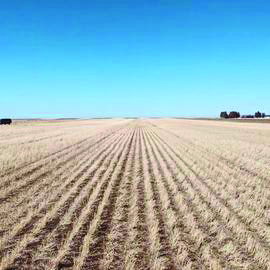While some growers and researchers are experimenting with drought-adapted varieties of existing crops, others are testing more substantial shifts in agricultural practices. One of those shifts is from annual grain crops that have to be replanted every year to perennial grains that produce a crop year after year without replanting.
In eastern Wyoming, a Western SARE-funded Professional + Producer project has dryland wheat growers experimenting with Kernza, a perennial intermediate wheatgrass that can be harvested for grain like wheat or used for forage to feed livestock.
Ph.D. students Hannah Rodgers and Alex Fox are working with University of Wyoming Professor Linda Van Diepen to see if Kernza can be viably grown in a region that’s not hospitable for many crops.
“Eastern Wyoming is the harshest of the harsh regions to practice dryland agriculture,” Rodgers said. “Many farmers here do a wheat-fallow rotation where they’re only growing one crop every other year and often they face crop failures. One grower told us he expects to get a good crop just two of every 10 years.”
Because of those pressures, many farmers in the region are abandoning their crops and switching over to cattle grazing, or taking their land out of production by enrolling in the U.S. Department of Agriculture’s Conservation Reserve Program where they’re paid to plant species that improve environmental health and quality, often perennial grasses.
“The current model of ‘let’s farm marginal lands until the soil health is so degraded we have to abandon them’ is not the best,” Rodgers said. “We know that right now Kernza can’t compete with wheat yields, but could it compete with CRP? The agronomic focus of our study is that – can Kernza provide growers enough yield and enough profit to outcompete these other land-use options?”
The team is also measuring soil-health benefits from planting Kernza instead of wheat-fallow, and looking at other potential environmental benefits, including capturing carbon from the atmosphere and storing it in the earth.
“In general, planting anything to perennials instead of annuals will have major benefits in terms of carbon sequestration,” Fox said. “Because you’re not tilling, you cause a lot less disturbance and allow more stable forms of carbon to build up in the soil like they do in a native prairie.”
And because Kernza’s roots can extend some 10 feet deep underground, about three times deeper than most wheat varieties, that carbon storage is more permanent and environmentally beneficial. It also makes the crop better suited to water-insecure areas.
“We’re getting a lot of questions from growers in northeast Colorado where they are worried about losing access to irrigation water and are looking for more drought-tolerant, deeper-rooted crops,” Fox said. “The USDA Agricultural Research Service in Fort Collins has a large Kernza research division and we’ve been able to feed some information from our study into that larger research project.”
They also see uses for Kernza in marginal areas in more hospitable climates.
“Even in wetter environments where it can’t compete with higher-yielding crops, Kernza could be a good alternative for marginal areas of a farm or in hard-to-reach places that have really poor soil health or weed problems,” Rodgers said. “There you can just plant Kernza and not invest much time or material into managing it. Maybe you get a grain yield off of it if you have the time, or you get a forage cutting, or you just leave it and come back next year.”
Both researchers acknowledge that, all things being equal, Kernza isn’t an economically viable option to replace wheat yet, but that ongoing development of the grain could change the equation in the coming decades.
